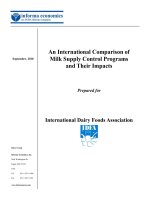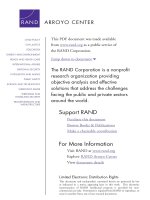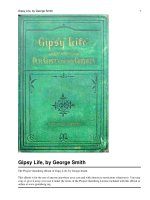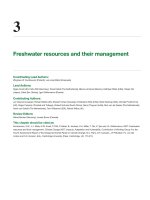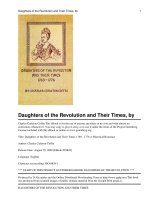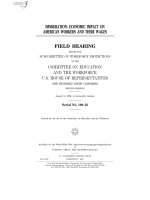Phenolic constituents from Alisma plantago-aquatica Linnaeus and their anti-chronic prostatitis activity
Bạn đang xem bản rút gọn của tài liệu. Xem và tải ngay bản đầy đủ của tài liệu tại đây (936.02 KB, 5 trang )
Huang et al. Chemistry Central Journal (2017) 11:120
DOI 10.1186/s13065-017-0350-9
Open Access
RESEARCH ARTICLE
Phenolic constituents from Alisma
plantago‑aquatica Linnaeus and their
anti‑chronic prostatitis activity
Ya‑sheng Huang1,2, Qi‑qi Yu2, Yin Chen2, Min‑jie Cheng2 and Li‑ping Xie1*
Abstract
Background: The plant Alisma plantago-aquatica Linnaeus, which is widely distributed in southwest of China, is the
main material of traditional Chinese medicine “Zexie”. It was used as folk medicine for immune-modulation, antitumor, anti-inflammatory and antibacterial. Previous chemical studies on A. plantago-aquatica reported the identifica‑
tion of triterpenes, diterpenes, sesquiterpenes, steroids, alkaloids and phenolic acid. Terpenes and phenolic acid were
regard as major secondary metabolites from this medicine plant.
Results: A new phenolic acid, plantain A (1), along with four known compounds (2–5) were isolated and identified
from A. plantago-aquatica by extensive chromatographic and spectrometric methods. In the present study, the levels
of TNF-α, IL-1β, COX-2, PEG2 and TGF-β1 were increased in model group rats, whereas on treatment with the isolated
compound (1 and 4) at 50 mg/kg, there was a significant decrease in the cytokine levels. Therefore, the anti-CNP
effect of 1 and 4 may be related to their anti-inflammatory properties.
Conclusions: A new phenolic acid and four known phenolic compounds were isolated from A. plantago-aquatica.
Moreover, compounds 1 and 4 shows significant anti-chronic prostatitis activity in rats.
Keywords: A. plantago-aquatica, Plantain A, Chronic prostatitis
Background
Prostatitis is a common urological disease causing urination abnormalities, including urinary urgency, frequent
urination, micturition, and dysuria. It also can cause
suprapubic, lumbosacral, and perineum pain, together
with sexual dysfunction, which is also known as prostatitis syndrome. Prostatitis is responsible for up to 2 million outpatient clinic visits per year, including 8% of all
male visits to an urologist and 1% of men presenting to
primary care physicians [1–3]. Cernilton is one of the
most widely used drugs for treating chronic non-bacterial prostatitis, but has not achieved significant curative
effect in clinic. Recently, more herbal medicine has being
used as alternative therapy for prostatitis [1, 2, 4–6]. Due
to its natural constituent and availability, natural herbs
*Correspondence:
1
Department of Urology, First Affiliated Hospital, School of Medicine,
Zhejiang University, 79 Qingchun Road, Hangzhou 310003, China
Full list of author information is available at the end of the article
which obtained from natural sources are believed to provide less untoward effect profiles and provide greater
effectiveness as compared to synthetic drug available
over the market.
The plant A. plantago-aquatica, which is widely distributed in southwest of China, is the main material of
traditional Chinese medicine “Zexie”. It was used as folk
medicine for immune-modulation, anti-tumor and antibacterial [7–9]. Previous studies on this plant revealed
that the water extract of A. plantago-aquatica showed
significant anti-chronic prostatitis activity in rats [2].
To further investigate the constituents and screen the
bioactive constituents from this herbal medicine, a phytochemical study was performed that resulted in the
isolation of one new compound, along with four known
phenolic components. Herein, we report the isolation,
structural elucidation, and anti-chronic prostatitis activity of compounds 1–5.
© The Author(s) 2017. This article is distributed under the terms of the Creative Commons Attribution 4.0 International License
( which permits unrestricted use, distribution, and reproduction in any medium,
provided you give appropriate credit to the original author(s) and the source, provide a link to the Creative Commons license,
and indicate if changes were made. The Creative Commons Public Domain Dedication waiver ( />publicdomain/zero/1.0/) applies to the data made available in this article, unless otherwise stated.
Huang et al. Chemistry Central Journal (2017) 11:120
Results and discussion
Chemistry
In continuation of our search for novel bioactive substances from this medicine plant, which has been proven
to possess anti-chronic prostatitis activity, one new
polyphenolic acid, plantain A (1), was isolated from A.
plantago-aquatica by using various chromatographic
methods, with four known phenolic compounds (2–5)
(Fig. 1). The structures of the other isolated components
ferulic acid (2), rynchopeterine A (3), rynchopeterine B
(4) and rosmarinic acid (5) were determined by comparison to the 1H- and 13C-NMR spectral data in the literatures [10–12].
Compound 1, which had the molecular formula
C34H26O13, deduced from the positive-ion HR-ESIMS
(m/z 665.1273 [M+Na]+) and 13C-NMR data. The
1
H-NMR spectrum showed that the presence of a
3,4-dihydroxyphenyl lactic acid moiety [δH 6.70 (1H, d,
J = 2.0 Hz, H-2″), 6.86 (1H, d, J = 8.0 Hz, H-5″), 6.60 (1H,
dd, J = 8.0, 2.0 Hz, H-6″), 3.06 (1H, dd, J = 14.8, 4.0 Hz,
H-7″a), 2.93 (1H, dd, J = 14.8, 8.8 Hz, H-7″b), 5.11 (1H,
dd, J = 8.8, 4.0 Hz, H-8″)], a (E)-cinnamoyl moiety with
three substituents in the benzene ring [δH 7.49 (1H, d,
J = 8.4 Hz, H-5), 6.67 (1H, d, J = 8.4 Hz, H-6), 7.86 (1H,
d, J = 16.0 Hz, H-8), 6.55 (1H, d, J = 16.0 Hz, H-9)], a
three-substituted dihydrofuran [δH 6.73 (1H, s, H-3)],
and a 3,4-dihydroxyphenyl [δH 7.41 (1H, d, J = 2.0 Hz,
H-2′), 6.78 (1H, d, J = 8.4 Hz, H-5′), 7.38 (1H, dd, J = 8.4,
2.0 Hz, H-6′)], suggesting that 1 was a polyphenolic acid
[13]. Additionally, the occurrence of a vanillic acid unit in
the molecule could be easily deduced from the 1H- and
13
C-NMR spectra [δH 7.52 (1H, d, J = 1.8 Hz), 7.48 (1H,
d, J = 7.8 Hz), 7.36 (1H, dd, J = 7.8, 1.8 Hz), 10.78 (1H,
Page 2 of 5
s), and 3.75 (3H, s); δC 144.5, 151.3, 114.3, 129.2, 126.3,
123.0, 168.4, 55.9] [14]. Comparison of the 1H- and 13CNMR data of 1 with those of salvianolic acid C (SAC) and
vanillic acid displayed that the signals were substantially
coincident [15]. All the above evidence combined with
the detailed 2D-NMR analysis of 1H-1H COSY, HMBC
and ROESY (Figs. 2, 3) correlations also implied that
compound 1 was composed of SAC unit and vanillic
acid unit. Moreover, the C-9″ carboxyl group of the SAC
moiety was attached to the C-1′′′ hydroxy group of the
vanillic acid. The structure of 1 is an ester dimer of SAC
and vanillic acid between the hydroxyl group at C-1′′′ and
the carboxylic acid group at C-9″. The suggestion was in
accord with the observation of the chemical shift of C-9″
signal upfield shifted from δ 173.8 in SAC to δ 170.5 in 1
and the chemical shift of C-1′′′ signal upfield shifted from
δ 151.2 in ADPP to 144.5 in 1 [16, 17]. This was further
supported by ROESY correlations of 2′′′-OCH3 with H-5″
and H-6″ and acid hydrolysis of compound 1 with 10 N
HCl gave SAC and vanillic acid, which was confirmed by
HPLC analysis. Thus, the structure of 1, which was established as shown in 1, is a new phenolic compound, which
we named plantain A.
Biological assay
Experimental chronic non-bacterial prostatitis (CNP)
was induced in rats by injecting carrageenan into prostate. Rats in drug-treated groups were administered the
isolated compounds (1–5) or cernilton (positive control,
i.e., reference standard) for 3 weeks while rats in normal
and negative control groups were treated with saline at
the same time. After treatment, the relative inflammatory
factors, tumor necrosis factor-α (TNF-α), interleukin 1β
Fig. 1 Chemical structures of compounds 1–5 isolated from A. plantago-aquatica
Huang et al. Chemistry Central Journal (2017) 11:120
Page 3 of 5
Experimental
General procedure
NMR spectra were recorded on a Bruker AM-400 spectrometer (Bruker, Karlsruhe, Germany) using standard
Bruker pulse programs. Chemical shifts are given as
δ values with reference to tetramethylsilane (TMS) as
internal standard. Column chromatography separations
were carried out on silica gel (200–300 mesh, Qingdao
Haiyang Chemical Co. Ltd, Qingdao, P.R. China), ODS
(50 mesh, Merck China, Beijing, China), Diaion HP-20
(Pharmacia, Peapack, NJ, USA) and Sephadex LH-20
(Pharmacia, Peapack, NJ, USA). GF254 plates (Qingdao
Marine, Qingdao, China) were used for thin layer chromatography, and spots were visualized under UV light or
by spraying with 5% H
2SO4 in ethanol followed by heating. All other chemicals used were of biochemical reagent grade.
Fig. 2 1H-1HCOSY and key HMBC correlations of 1
Plant material
Samples of A. plantago-aquatica were collected from
Liuzhou City, Guangxi Province in China in May 2015.
Taxonomic identification of the plant was performed
by Professor Li-ping Xie. A voucher specimen (No.
20150701) has been deposited in the authors’ laboratory.
Fig. 3 Key ROESY correlations of compound 1
Extraction and isolation
(IL-1β), cyclooxygenase-2 (COX-2), prostaglandin E2
(PEG2), and transforming growth factor-β1 (TGF-β1) of
the prostate tissues were measured by ELISA [2, 4].
As shown in Table 1, ELISA detection revealed that
compounds 1 and 4 treatments obviously reduced TNFα, IL-1β, PGE2, COX-2 and TGF-β1 levels compared
with the control group. Compounds 1 and 4 markedly
decreased the above inflammatory factors expression and
showed significant anti-chronic prostatitis activity in rats.
The dry A. plantago-aquatica (8 kg) were extracted two
times under reflux with hot water (100 L × 3 h). After
removing the solvent under reduced pressure, the residue
was suspended in water and then sequentially extracted
with petroleum ether, EtOAc and n-BuOH. The EtOAc
extract (103 g) was subjected to silica gel column chromatography (CC) using C
HCl3–MeOH (1:0–0:1) and
divided into six fractions. Fraction 1 was separated by CC
over silica gel using CHCl3–MeOH (9:1–7:3) and Sephadex LH-20 CC using MeOH to obtain 2 (24 mg) and 3
(27 mg). Fraction 3 was separated by CC on Si gel using
Table 1 Effect of compounds 1–5 on TNF-α, IL-1β, PGE2, COX-2,TGF-β1 levels
Group
Control
Negative control
TNF-α (pg/mL)
IL-1β (pg/mL)
91.4 ± 6.1**
89.3 ± 7.2**
173.8 ± 11.2
160.3 ± 10.1
PGE2
(pg/mL)
57.2 ± 9.3**
130.2 ± 6.9
COX-2
(pg/mL)
17.1 ± 3.7**
41.4 ± 1.9
TGF-β1
(pg/mL)
84.8 ± 9.9**
133.1 ± 10.2
Cernilton
121.1 ± 10.5**
132.4 ± 9.7**
80.3 ± 5.7**
20.3 ± 2.4**
119.4 ± 11.7*
1
101.7 ± 9.9**
124.8 ± 8.0**
119.7 ± 10.9*
26.8 ± 4.1**
101.6 ± 9.7**
2
169.3 ± 11.7
156.7 ± 12.6
128.1 ± 11.7
39.7 ± 8.5
131.1 ± 12.2
3
161.1 ± 14.5
151.9 ± 10.3
125.7 ± 10.3
37.8 ± 6.2
129.8 ± 11.5
4
118.6 ± 10.3**
147.5 ± 11.2*
117.4 ± 8.3**
30.3 ± 1.8**
120.3 ± 11.4*
5
170.1 ± 9.4
159.9 ± 12.7
129.1 ± 11.9
40.1 ± 5.9
130.6 ± 10.3
Cernilton was tested at a dose of 30 mg/kg, the five compounds (1–5) were tested at a dose of 50 mg/kg
* p < 0.05, ** p < 0.01, significant as compared to the negative control group; Values are mean ± SD (n = 10)
Huang et al. Chemistry Central Journal (2017) 11:120
CHCl3–MeOH (8:2–6:4) to give subfraction 3–1 (5.5 g),
subfraction 3–2 (6 g) and subfraction 3–3 (12 g). Subfraction 3–3 was purified by semi-preparative HPLC to
afford compounds 1 (20 mg), 4 (27 mg), and 5 (30 mg).
Characterization of plantain A (1)
Obtained as brown amorphous powder, [α]25
D + 66.9° (c
0.10, MeOH); HR-ESIMS m/z 665.1273 (C34H26O13Na
[M+Na]+, Cal. 665.1271); IR vmax (KBr): 3433, 2940,
1601, 1524, 1446, 1360, 1282, 1192, 1110, and 1066 cm−1.
1
H-NMR and 13C-NMR (DMSO-d6) data see Table 2 (For
further information, see Additional file 1).
Acid hydrolysis of plantain A (1)
A solution (3 mg) of 1 in 10 N HCl (1.5 mL) was heated
at 100 °C for 5 min under an N2 atmosphere. After cooling, the solution was removed. The residue was dissolved
with methanol, stirred at 45 °C for 10 min. The methanol solution was analyzed by HPLC using Hypersil C18
Table 2 13C- and 1H-NMR data of 1 in DMSO-d6 (400 MHz
for H, 100 MHz for C)
No.
C
H
1
2
3
157.8
99.2 6.73 (1H, s)
No.
C
1″
131.5
2″
117.8
H
6.70 (1H, d,
J = 2.0 Hz)
3″
146.1
3a
127.9
4″
145.4
4
120.6
5″
115.5
6.86 (1H, d,
J = 8.0 Hz)
5
133.9 7.49 (1H, d,
J = 8.4 Hz)
6″
121.4
6.60 (1H, dd, J = 8.0,
2.0 Hz)
6
111.4 6.67 (1H, d,
J = 8.4 Hz)
7″
36.6
3.06 (1H, dd, J = 14.8,
4.0 Hz)
7
147.4
7a
142.8
8″
73.5
8
145.7 7.86 (1H, d,
J = 16.0 Hz)
9″
170.5
9
119.5 6.55 (1H, d,
J = 16.0 Hz)
1′′′
144.5
10
166.7
2′′′
151.3
1′
120.6
3′′′
114.3
2′
112.9 7.41 (1H, d,
J = 2.0 Hz)
4′′′
129.2
3′
147.8
5′′′
126.3
7.48 (1H, d,
J = 7.8 Hz)
4′
148.8
6′′′
123.0
7.36 (1H, dd, J = 7.8,
1.8 Hz)
5′
116.5 6.78 (1H, d,
J = 8.4 Hz)
COOH 168.4
6′
117.2 7.38 (1H, dd,
OCH3
J = 8.4, 2.0 Hz)
2.93 (1H, dd, J = 14.8,
8.8 Hz)
55.9
5.11 (1H, dd, J = 8.8,
4.0 Hz)
7.52 (1H, d,
J = 1.8 Hz)
10.78 (1H, s)
3.75 (3H, s)
Page 4 of 5
(250 mm × 4.6 mm). The HPLC linear gradient profile
was as follows: water (containing 0.5% phosphoric acid),
acetonitrile (containing 0.5% phosphoric acid) 54:46 v/v
(0–15 min), 54:46–20:80 (15–20 min), and 20:80 (20–
30 min) at a flow-rate of 1 mL/min. The separation was
carried out at 25 °C. Compounds were analyzed 286 nm.
The peak identity of each component was confirmed by
comparison of the retention time. Retention times of
SAC, plantain A, and vanillic acid were 17.15, 20.52 and
10.08 min.
Animals
Eight weeks old male Wistar rats (220–250 g) were provided by the Laboratory Animal Center of Zhejiang University (Certificate no. SYXK 2012-0178). The animals
had free access to feed and water, and were allowed to
acclimatize for at least 1 week before use. The drugs were
dissolved in water, and administered using a 5 mL syringe
with a 4 cm long gavage needle through the mouth once
daily for 3 weeks.
Biochemical assays
Chronic non-bacterial prostatitis were induced as previously described. Prostates of rats in control group were
injected with 0.1 mL saline by an injector, and the same
volume of 1% carrageenan in rats of other groups. Seven
days after preparing the model rats of chronic nonbacterial prostatitis, rats in sample group, they were orally
administered compounds 1–5, while rats in positive (reference standard) group were. Administered cernilton,
both groups for 3 weeks. Rats of normal and negative
control groups were administered saline at the same time
[2, 4].
After the rats were sacrificed by cervical dislocation,
the pro-inflammatory cytokines TNF-α and IL-1β of
prostate tissues of all rats were measured by commercial
ELISA assay kits, according to manufacturer’s instruction. The samples and standards were all run in duplicates and the data were then averaged. The results were
expressed as pg/mL.
PGE2, COX-2, and TGF-β1 were measured in prostate
tissues using commercial ELISA kits. All assays were performed in 10% prostate supernatant in accordance with
manufacturer’s instructions. The levels of PGE2, COX-2,
and TGF-β1 in prostate tissue are expressed in pg/mL [1, 2].
Statistical analysis
Data analysis was performed by one-way analysis of variance with the Dunnett’s post hoc test for multiple comparisons by SPSS 10.0 software. Data were expressed as
the mean ± standard error of the mean (SEM). The level
of statistical significance was set at p < 0.05 (Additional
file 1).
Huang et al. Chemistry Central Journal (2017) 11:120
Additional file
Additional file 1. Figure S1 1H NMR spectrum (400 MHz, DMSO-d6)
of compound 1. Figure S2 13C NMR spectrum (400 MHz, DMSO-d6) of
compound 1. Figure S3 1H-1H COSY spectrum (400 MHz, DMSO-d6) of
compound 1. Figure S4 HMBC spectrum (400 MHz, DMSO-d6) of com‑
pound 1. Figure S5 HR-ESIMS spectrum of compound 1.
Authors’ contributions
YSH and QQY isolated the compounds, YSH and MJC elucidated the structure
and wrote the manuscript, LPX and YC carried out the bio-assays and brought
some corrections to the paper. All authors read and approved the final
manuscript.
Author details
1
Department of Urology, First Affiliated Hospital, School of Medicine, Zhejiang
University, 79 Qingchun Road, Hangzhou 310003, China. 2 Department of Urol‑
ogy, Hangzhou Hospital of Traditional Chinese Medicine, Hangzhou 310006,
China.
Competing interests
The authors declare that they have no competing interests.
Ethics approval and consent to participate
Not applicable.
Publisher’s Note
Springer Nature remains neutral with regard to jurisdictional claims in pub‑
lished maps and institutional affiliations.
Received: 31 August 2017 Accepted: 10 November 2017
References
1. Shan PN, Lu ZY, Ye LH, Fang YQ, Tan SH, Xuan GH, Ru JC, Mao LM (2016)
Effect of Tripterygium wilfordii polyglycoside on experimental prostatitis
caused by Ureaplasma urealyticum in rats. Med Sci Monit 22:3722–3726
2. Wang XM, Wang DD, Wu YZ, Ma PD, Sun G, Xu Y (2017) Effect of Alisma
plantago-aquatica Linn extract on chronic prostatitis in rats. Trop J Pharm
Res 16:1091–1095
Page 5 of 5
3. Weidner W, Brunner H, Krause W (1980) Quantitative culture of Ureaplasma urealyticum in patients with chronic prostatitis or prostatosis. J
Urol 124:622–625
4. Ding HY, Qian WQ, Xu J (2017) Effect of Achyranthes bidentata blume
extract on carrageenan-induced chronic prostatitis in rats. Trop J Pharm
Res 16:855–899
5. Xiong YY, Qiu XT, Shi WJ, Yu H, Zhang XL (2017) Anti-inflammatory and
antioxidant effect of modified Bazhengsan in a rat model of chronic
bacterial prostatitis. J Ethnopharmacol 198:73–80
6. Song GH, Zhang QM, Pang BZ, He LJ, Julaiti S, Aisikeer T, Gao X, You LN,
Reyihan W, Zhou WT (2015) Effects of different Chinese herbal prescrip‑
tions on cytokines in autoimmune prostatitis rats. J Tradit Chin Med
35:211–217
7. Jung HW, Jin GZ, Kim SY (2009) Neuroprotective effect of methanol
extract of Phellodendri cortex against 1-methyl-4-phenylpyridinium
(MPP+)-induced apoptosis in PC-12 cells. Cell Biol Int 33:957–963
8. Poggio C, Trovati F, Ceci M, Chiesa M, Colombo M, Pietrocola G (2017)
Biological and antibacterial properties of a new silver fiber post: in vitro
evaluation. J Clin Exp Dent 9:e387–e393
9. Xian YF, Mao QQ (2011) Comparison on the anti-inflammatory effect
of cortex Phellodendri chinensis and cortex Phellodendri amurensis in
12-O-tetradecanoyl-phorbol-13-acetate-induced ear edema in mice. J
Ethnopharmacol 137:1425–1430
10. Lin SQ, Zhou ZL, Yin WQ (2016) Three new polyphenolic acids from the
leaves of Eucalyptus citriodora with antivirus activity. Chem Pharm Bull
64:1641–1646
11. Xiao H, Yin TP, Dong JW, Wu XM, Luo Q, Luo JR, Cai L, Ding ZT (2017) Five
new phenolic compounds with antioxidant activities from the medicinal
insect Blaps rynchopetera. Molecules 22:1301
12. Kong LJ, Liang QL, Wu QN, Jiang JH (2011) Chemical constitutes of Sparganium stoloniferum. Chin Tradit Herbal Drugs 42:440–442
13. She GM, Xu C, Liu B, Shi RB (2010) Polyphenolic acids from Mint (the
Aerial of Mentha haplocalyx Briq.) with DPPH radical scavenging activity. J
Food Sci 75:c359–c362
14. Liu YM, Jiang BP, Shen SN, Guo Z, Li ZY, Si JY, Pan RL (2014) Chemical
constituents from leaves of Cajanus cajan. Chin Tradit Herbal Drugs
45:466–470
15. Ai CB, Li LN (1988) Stereostructure of salvianolic acid B and isolation of
salvianolic acid from Salvia Miltiorrhiza. J Nat Prod 51:145–149
16. Liu SS (2011) Study on the preparation technology and isolation and
identification of related substances of salvianolic acid A. Shandong
University, Shandong, pp 65–67
17. Fu M, Wei L, Yu J, Hu ZT (2013) Chemical constituents of Penthorum
chinense Pursh. Chin Phram J 48:1911–1913

